|
“Ancient henge discovered near city”
December 31, 2004, The Chester Chronicle, England: “Wiltshire may have Stonehenge but now Cheshire has a wooden henge after archaeologists made the discovery near Chester.
Researchers working at Poulton, on the Duke of Westminster’s land, were amazed to find the Bronze Age burials they had been investigating were preceded by a much earlier ‘ritual’ presence.
A circle of holes indicated the existence of the wooden henge together with a large hole in the centre which was potentially a form of ‘totem pole’.
The causeway into the area is aligned to the position of Orion’s Belt in the summer sky. It also aims, unerringly, for a gap in the Cheshire Sandstone Ridge.”
[Full Story]
“Newgrange casts spell on the press”
December 26, 2004, The Times, UK: “At sunrise on the year’s shortest day, as every Irish schoolchild knows, a shaft of sunlight illuminates the central chamber of the megalithic passage tomb at Newgrange in Co Meath.
Less widely acknowledged is the equally spectacular effect that the sight of this simple sunbeam can have on the more wide-eyed of the reporters who convene to cover the event. In recent years, the annual Newgrange light show has turned their prose a funny shade of purple.
The 2004 award for the most florid dispatch from the golden dawn goes to Eileen Battersby, the Irish Times’ literary editor who on Wednesday waxed long and lyrical about her Boyneside encounter with the winter solstice.
‘Yesterday was perfection’, wrote Battersby. ‘In the flood of warm honey light, mere words became redundant. Tom Parlon, the minister of state at the Office of Public Works, exited the passageway as if he had seen a vision.’“
[Full Story]
“A Spectacular Winter Solstice at Newgrange Ireland”
December 22, 2004, eMediaWire, USA: “The Megalithic Passage Tomb at Newgrange was built about 3200 BC. The mound covers an area of over one acre and is surrounded by 97 kerbstones, some of which are richly decorated with megalithic art.
The 19 metre long inner passage leads to a cruciform chamber with a corbelled roof. It is estimated that the construction of the Passage Tomb at Newgrange would have taken a work force of 300 at least 20 years (ref:http://www.knowth.com)
The great feat of building the monument is surpassed by it’s design to align itself with the sunrise of the winter solstice. This happens every year on the 21st December.
On a clear morning like today we watched as the sun rose over the horizon and sent a shaft of sunlight through the ‘Box’ to light up the center of the burial chamber.”
[Full Story]
“Iranians celebrate ‘Yalda’ as longest night of the year”
December 21, 2004, Payvand, Iran: “Millions of Iranians all over the world Monday night will celebrate ‘Yalda’, the longest night of the year and the first night of winter as a token of victory of the angel of goodness over the devil of badness.
‘Yalda’ is a Syriac word meaning birth and according to Mithraism, a faith that initially originated from Persia and later spread out throughout the ancient civilized world, the first day of winter which falls on December 21 this year, was celebrated as the birthday of Mithra, the angel of light.
Ancient Iranians believed that two groups of angels – good and bad – were in constant fight on the earth with each other and that on the dawn of the first day of the month of ‘Dey’, beginning December 21, and with the victory of the rising sun as the symbol of ‘Ahuramazda’, the Zoroastrian god, over the evil of darkness the fight would come to an end.”
[Full Story]
“Greek Astronomy to Copernicus era?”
December 21, 2004, International reporter, India: “Greek Astronomy has a long history of philosophy. After Ptolemy and especially after the fall of Roman Empire, the world was divided into two major opinions, movements and religions i.e. Christianity and Islam.
The main reason was that the people of both religions did not allow any modification in the Greek picture of Astronomy.
The post-Christian type people were seriously concerned in protecting their divine interests more than opposing their acts of observing the celestial bodies.
They had no objection for the people for linking their divine thinking with Astronomy but they were against Astrology or any other such science that could possibly drag their followers away from God.
That period obstructed the progress of science because the attention of the people was divided more towards the religious culture within the influence of their church, rather than scientific progress in Astronomy.”
[Full Story]
“The winter solstice at Brú na Bóinne in County Meath, Ireland”
December 18, 2004, The Daily Telegraph, UK: “The winter solstice is a significant date at the great Stone Age burial ground of Brú na Bóinne in County Meath, Ireland.
At dawn on this day and for a couple of mornings either side of the solstice, a small opening in the roof of the great Newgrange passage tomb, one of the most important sites in the Brú na Bóinne area, allows the rays of the winter sun briefly to lift the gloom of the passage and adjoining chamber (weather permitting).
The enormous tomb, by far the most impressive Neolithic burial site in Europe, is more than 400ft long and 40ft high – and it is probably the oldest known deliberately aligned structure anywhere in the world.
Brú na Bóinne visitor centre (00353 41 988 0300, www.heritageireland.ie) is open daily except December 24-27; winter hours 9.30am-5pm. Guided tours depart throughout the day. The site is two miles south of Slane. Application forms to see the winter solstice can be obtained from the visitor centre.”
[Full Story]
“Grisly find casts doubt on peaceful pyramid theory”
December 06, 2004, Mail & Guardian, South Africa: “The ancient city-state of Teotihuacan was long thought a relatively gentle place because its art lacked the glorification of sacrifice and war so common in other Mesoamerican civilisations.
Now a team of archaeologists has gone beneath that peaceful appearance and revealed the skeletons in the city’s pyramid.
The first ever excavation of the 1 900-year-old Pyramid of the Moon has uncovered the bones of a dozen adult males, 10 of them decapitated and all of them apparently offered up to the gods.
Three other smaller-scale human offerings were also found in the seven-year project, which tunnelled deep into the solid stone-and-earth structure.”
[Full Story]
“Calendars Tell Ancient and Modern Farmers When to Plant”
December 06, 2004, eMediaWire, USA: “Calendars were important to agricultural people, allowing them to predict when to plant and harvest crops, or to breed their livestock. Moon calendars were first used to mark the passage of time. Planting by the moon has been practiced for thousands of years, but it is also based on the scientific fact of the gravitational pull of the moon, which draws the moisture in the earth to the surface, aiding in germination of seeds.
Ancient people used the natural signs that they could observe to mark the passage of time: the sun, the moon and the seasons.
The changing shape of the moon was easiest for them to observe, and served as a convenient interval for marking time. The very first calendars, dating back to 25,000 BC, were notched sticks, reindeer bones, or tusks of mammoths, which counted the days between phases of the moon. It was also important to track the seasons so they would know when the weather would change for planting or harvesting, or when to expect migrating herds.
In the prehistoric caves of Lascaux, France there is a lunar calendar that shows patterns of dots, representing a way of counting the days. According to Dr. Rappenglueck of the University of Munich, there is ‘one dot for each day the moon is in the sky. At the new moon, when it vanishes from the sky we see an empty square, perhaps symbolically representing the absent moon. It was a rhythm of nature that was important to these people. Their survival depended on them, they were part of them.’
Lunar calendars were used by Celts, Islamic and Jewish people, and in Germany, Babylonia, and China. The Aztec Priests had a 260-day lunar calendar that they used to determine the best days for sowing crops, building houses or going to war. The Mayans also used observations of the planet Venus to create their calendar.
Native Americans kept track of days by counting from a bundle of sticks. Observation of the Moon was used for longer intervals, usually beginning with the New Moon. Most tribes counted 12 moons a year, some thirteen, with names like ‘Grass Moon’, ‘Corn Moon’ or ‘Harvest Moon’. Years were divided into four seasons, but not by a fixed number of days.”
[Full Story]
“Archaeologists uncover a Russian ‘Stonehenge'”
November 12, 2004, RIA/Novosti, Russia: “Russia now has a Stonehenge of its own. In the summer, a 4,000-year-old megalithic structure was uncovered at a Spasskaya Luka site, in the central Russian region of Ryazan.
This structure, which, archeologists believe, was built as a sanctuary, sits on a hill overlooking the confluence of the Oka and the Pron rivers. The surrounding area has always been seen as an ‘archeological encyclopedia’, a kaleidoscope of cultures ranging from the Upper Paleolithic to the Dark Ages.
‘If we look at this archeological site as represented on a map, it will be a circle seven meters in diameter, marked with pillars, half a meter thick and the same distance apart from each other’, says the expedition leader Ilya Akhmedov, who works in the Moscow Historical Museum’s Archeological Monuments Department.
‘Here’s a large rectangular hole and a pillar in the center of the circle. The wooden pillars have not survived, of course, but the large holes from which they once stuck out can be seen pretty clearly. Along the edges of the site there are two more holes.’
The two pillar pairs form a gateway, which, if looked through from the center, will provide a spectacular sunset view in the summertime. Another pillar, behind the circular fence, points to where the sun rises. The monument’s structure has prompted scholars to advance a hypothesis about its astronomical purpose.”
[Full Story]
“Zodiac bronzes of Yuanmingyuan to be on display”
October 19, 2004, XinhuaNet, China: “Four pieces from a bronze set of 12 Chinese zodiac signs dating from the Qing Dynasty (1644-1911) taken out of the country in 1860 by British and French archaeologists will be on display at the First International Cultural Industry Fair to be held from Nov. 18 – 22.
These are the bronze heads of a tiger, a pig, an ox and a monkey, which will be displayed at a special exhibition hall of the TV center, next to the old China Hi-Tech Fair Exhibition Center, reported Shenzhen Daily.
These pieces are among the 12 sculptures featuring humans with animal heads. The sculptures, representing the Chinese zodiac, originally guarded a building in Yuanmingyuan, the old imperial summer palace in Beijing.”
[Full Story]
“Germany’s Bronze Age Blockbuster”
October 14, 2004, Deutsche Welle, Germany: “The 3,600 year old Sky Disk of Nebra – the world’s oldest image of the cosmos – is the centerpiece of the biggest Bronze Age show of Europe, in the eastern German town of Halle.
It caused a world-wide sensation when it was brought to the attention of the German public in 2002, having been discovered in the state of Saxony-Anhalt two years earlier.
|
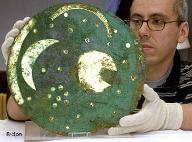
Deutsche Welle, Germany
|
|
Now the Sky Disc of Nebra – a bronze disc with gold-leaf appliques representing the sun, moon, stars and a ship – is back in the limelight, at the opening of a blockbuster show entitled ‘The Forged Sky: The Wide World in the Heart of Europe 3,600 Years Ago.’
|
For the first time the disc, which is around 32 centimeters (12 inches) in diameter and weighs about 2 kilos (1 pound), will be on public view in its fully restored state.
The disc itself was a cult object, and describes the world view during the Bronze Age. People imagined the earth as a disc, with a dome-shaped sky covering it. A cluster of seven dots has been interpreted as the Pleiades constellation as it appeared 3,600 years ago.
At the same time, the piece is thought to be related to primitive observatories, one of which is the “German Stonehenge” in the nearby town of Goseck. Archeologists believe the disc may have been used in the pre-calendar Bronze Age as an instrument for determining seasonal changes.”
[Full Story]
“Islamic Contributions to Science & Math: Astronomy in Baghdad”
October 2004 Edition, NetMuslims.com, USA: “Baghdad, the fairy city of the Arabian Nights and capital of the famous Harun-ar-Rashid, the greatest emperor of his time, had the distinction of being the foremost centre of art and culture during mediaeval times.
Renowned scholars and translators, artists and scientists flocked to this great metropolis from all parts of the world and adorned the learned assemblies of Harun and Mamun, who, besides being celebrated scholars themselves, were the greatest patrons of learning that the world has ever known. The Darul Hukama (House of Wisdom) founded by Mamun-ar-Rashid in Baghdad housed some of the most eminent scholars of the world belonging to different castes and creeds.
Astronomy, in the real sense, started among the Arabs during the early period of the Abbasid Caliphate. It was much influenced by Sidhanta, a work in Sanskrit brought from India to Baghdad and translated into Arabic by Ibn Ibrahim al-Fazari and later on by Abu Musa Khwarizmi.
Pahlavi tables (zij) compiled during the Sasanid period and Greek astronomical works translated during this period prepared the ground for Arabian astronomy. Ptolemy’s Al-magest went into several translations in Arabic – the best being the one by Hajjaj Ibn Mater (827-28) and another by Humayun Ibn Ishaq, revised by Thabit bin Qurra (d/901).
Khwarizmi has written a valuable treatise on astronomy and has compiled his own Tables (zij) which, after two centuries was revised by Spanish atronomer Majriti (011007) and was translated into Latin by Adelard of Bath. This formed the basis of later astronomical pursuits both in the East and the West and replaced all earlier tables of Greek and Indian astronomers. This table was also adopted in China.
The Arab civilization of Spain rivalled that of the Abbasid’s in the East, and during the middle of the 10th century astronomical studies were especially favoured by the rulers of Muslim Spain. The outstanding Spanish astronomers were Al-Majriti of Cordova, al-Zarqali (1029–1087 A.D.) of Toledo, Ibn Afiah (d/2140-50 A.D.) of Seville and Nur-ud-din Abu Ishaq al-Bitruji.
In his famous work Kitab al Hayat (book of astronomy), which was later translated into Latin by Gerard of Cremona, Jabir Ibn Afiah, the celebrated astronomer of the twelfth century, sharply criticised Ptolemy. Against the observations of Ptolemy he rightly observed that the lower planets, Mercury and Venus, have no visible parallaxes. His generalisations of the subject were confirmed by later research.”
[Full Story]
“The Lost City of Cahokia”
October 2004 Edition, Humanities Magazine, USA: “The city of Cahokia, in modern-day Illinois, had a population of twenty thousand at its pinnacle in the 1300s. With pyramids, mounds, and several large ceremonial areas, Cahokia was the hub of a way of life for millions of Native Americans before the society’s decline and devastation by foreign diseases.
Representatives from eleven tribes are working alongside archaeologists and anthropologists to assist the Art Institute of Chicago in developing an exhibition that explores artistic and cultural themes of a major branch of pre-Columbian civilization–the direct ancestors of most American Indians today.
‘Hero, Hawk and Open Hand: American Indian Art of the Ancient Midwest and South,’ opening November 20, comprises more than three hundred works. It’s one of the largest showings of artifacts, design, and architecture dating from the rise and decline of Mississippian civilizations in the Midwest and the South between 2000 B.C.E and 1600 C.E.
The archaeological record is more complete: it begins with hunting and gathering peoples of the late Pleistocene epoch during the last phases of the Ice Age. They hunted mammoths and bison as well as deer, and collected fruits and plants in season. Their stone axe heads and other objects show a high level of symbolic activity, Townsend says. The largest known settlement, located on the banks of the river Bayou Maçon in northeastern Louisiana, was anchored by a fifty-foot-high ceremonial mound aligned to the sun’s path.
Around 500 B.C.E. central Ohio became a beehive of new cultural activity. The Adena people built conical mounds to commemorate tribal leaders, and their practices were expanded by the Hopewell culture, which existed between the years 1 and 400 C.E. The Newark Earthworks is perhaps the best known.
‘The earthworks were not just symbols on the landscape, they were built to be part of the landscape; and, perhaps, to allow their builders to transcend the boundaries of the terrestrial sphere. In one section, called Observatory Mound, the intricate 18.6-year cycle of the moon can be encompassed by four points on the eastern horizon marking a maximum northern moonrise, a minimum northern moonrise, a maximum and minimum southern moonrise, and four points on the western horizon marking the corresponding moonsets.’“
[Full Story]
“Exploring the mysteries of Xi’an’s imperial tombs”
September 03, 2004, China Daily, China: “Dynasties and empires rose and fell along the Wei He River valley, where Xi’an lies. While the emperors are gone, their legacy awaits the spades and brushes of archaeologists exploring this crucible of Chinese history and culture.
The terracotta warriors, one of archaeology’s greatest accidental finds, hint at what else could lie under the barely scratched fields where emperors and aristocrats lie interred beneath 500 burial mounds.
These tombs rise out of a fertile plain where orchards, renowned throughout Shaanxi for their crispy apples along with maize and other vegetables, form a pleasing agricultural mosaic. Come winter, the region takes on a starker beauty, eerie when dense fogs descend, shrouding the tombs.
Burial mounds, tombs, pyramids, call them what you will – they squat in other corners of Asia as well as the Middle East, Europe and Latin America.
While some of the Wei He valley tombs bear comparison with the long barrows found around England’s Salisbury Plain and elsewhere in northern Europe, a few investigators draw more astonishing connections.
Hartwig Hausdorf, a German writer who researches unexplained phenomena, suspects the involvement of aliens. Black Africans played a crucial role in their construction, suggests historian Legrand Clegg, who points to evidence of a negroid people in China.
There is also a theory that the Xi’an mounds map the Gemini constellation as it would have appeared on the horizon at spring equinox, 10500 BC. Coincidentally (or perhaps not?) Egypt’s Great Pyramid complex was built to map Orion’s position in the skies in 10500 BC, or so says British expert on unexplained phenomena Graham Hancock.”
[Full Story]
“Star chart in ancient Nara tomb to undergo restoration”
July 12, 2004, Mainichi Daily News, Japan: “Japan’s Agency for Cultural Affairs released a photograph of an ancient astronomical chart discovered on the wall of the Kitora tomb in Asuka, Nara Prefecture, on Monday as agency researchers decided to remove the chart and restore it.
Since the chart is peeling from the roof of the tomb, researchers had been discussing how to restore it and other murals.
Some had expressed opposition to removing the murals because of failed attempts overseas, but they later decided there was no other way to preserve them.”
[Full Story]
“Ruins’ holes mark solstice”
June 14, 2004, Tri-Valley Central, USA: “The Hohokam could easily be considered prehistoric astronomers. Researchers and visitors alike have long questioned the significance of mysterious holes bored through the walls of the Big House at the Casa Grande Ruins National Monument.
|
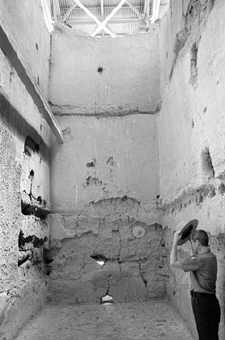
Tri-Valley Central
|
|
The holes – five in the east wall, one in the south, one north, and two west – appear to serve as a primitive seasonal calendar, indicating the spring and autumn equinoxes as well as summer solstice and lunar events. However, researchers can merely speculate what purpose this celestial understanding served for the Hohokam culture, which flourished about 700 years ago.
Ranger Denise Shultz explains the function of the summer solstice hole at the Casa Grande Ruins. This hole, located towards the north end of the west wall, perfectly frames the setting sun on or around June 21 of every year, indicating the summer solstice.
|
CGRNM Ranger Denise Shultz defines four major astronomical holes: a summer solstice alignment hole in the north end of the west wall, a lunar alignment hole in the south end of the west wall, and towering four stories high in the center room of the Casa Grande are the spring and fall equinox holes – one in the east wall, one in the west.
‘The summer and lunar events are a little more difficult to see happen because there aren’t any floors anymore, so you’re not at the right viewing level,’ Shultz said. ‘But the equinox alignment is still visible.’
Just after sunrise, a beam projected through the east wall hole onto the west wall slowly approaches and then aligns perfectly with the west hole. This happens around the spring and fall equinoxes each year. Shultz said that the timing isn’t always exact, but the alignment does only occur two days a year.”
[Full Story]
“Celestial Dragon: Draco, an Ancient Guardian”
June 25, 2004, Space.com, USA: “While most folks are familiar with the Big and Little Dipper, in the same region of the sky is a long, winding group of stars which portrays the mythological creature of a dragon named Draco, which during late evening hours is riding high above Polaris, the North Star.
Draco is a very ancient grouping. The earliest Sumerians considered these stars to represent the dragon Tiamat. Later it became one of the creatures that Hercules killed.
One of Dracos tasks was to guard the garden of Hesperides and its golden apples that Hercules was supposed to retrieve. In the stars, Draco coils around Polaris and we now see Hercules standing (albeit upside down) on Dracos head.
Within Draco is the star Alpha Draconis, better known as Thuban. Interestingly, this third-magnitude star used to be the North Star about 4,500 years ago. In fact, a passage in the Great Pyramid of Giza, constructed about that time, was aligned on that star. Today, of course, the North Pole of the sky is marked by the star Polaris at the end of the handle of the Little Dipper.”
[Full Story]
“Archaeologists ‘link Stonehenge to Wales'”
June 21, 2004, The Western Mail, Cymru: “Stonehenge was built by a Welsh family, archaeologists now believe. The discovery of an early Bronze Age grave, made by workmen laying pipes on Salisbury Plain, is further proof that England’s ancient landmark is a Welsh export.
Chemical tests on the 4,300-year-old teeth of seven people unearthed on Boscombe Down, Wiltshire, show they came from South West Wales or the Lake District.
But because the stones are bluestone brought from the Preseli mountains in Pembrokeshire, experts say the remains almost certainly belong to people born in Wales, who were among Stonehenge’s builders.
It is the first time human remains have been found that link the mysterious ceremonial site with the north Pembrokeshire origins of the 80 standing stones.”
[Full Story]
“Teen to present work at professional
archaeoastronomy conference”
June 21, 2004, USA Today, USA: “Research work by a Flagstaff High School student will be presented alongside that of professional scientists at an archaeoastronomy conference at Northern Arizona University this week.
James Cahill, an incoming senior, will be one of just 19 people to present a poster at the Seventh International Oxford Conference on Archaeoastronomy. Posters are displays illustrating the research work.
Cahill’s poster is based on his discovery that a hole in the wall of a local ancient pueblo is aligned precisely to focus the sun’s rays only during the spring and fall equinoxes.”
[Full Story]
“Interactive online map offers unprecedented
access to Stonehenge”
June 11, 2004, 24-Hour Museum, England: “English Heritage is now offering unprecedented access to the Stonehenge World Heritage Site in the form of a new micro-website, launched on June 11.
|
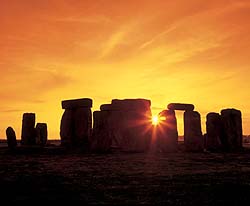
24-Hour Museum
|
|
For the first time, visitors can explore the entire archaeological landscape that surrounds the world famous stone circle from the comfort of their desktops.
‘We want to help people appreciate the wealth of prehistoric sites surrounding Stonehenge,’ explained Isabelle Bedu, Stonehenge World Heritage Site Coordinator, in charge of this project at English Heritage..
|
Halley’s comet, which was last visible in 1986, has cropped up periodically in the Earth’s history, with regular observations in 1531, 1607 and 1682.
‘The aim of the interactive map is to bring to life the whole World Heritage Site and its many mysterious monuments. We hope that many people around the world will enjoy their virtual tour.’
Stonehenge began as an earthen ditch and bank built around 3,000BC. The stones were erected and rearranged several times between 2,500BC and 1,600BC and are now recognised as the most sophisticated stone circle in Europe.
The landscape surrounding it offers an unusual concentration of Neolithic and Bronze Age burial mounds (more than 350 altogether) and large-scale ceremonial monuments such as the Avenue, the Cursus and Durrington Walls.
The whole thing can now be explored online in English Heritage’s new microsite, which has been created by web content management system company Oxford ArchDigital.”
[Full Story]
“Halley’s comet portrayed on ancient coin”
May 19, 2004, ABC News in Science, Australia: “A rare ancient coin may feature an early record of Halley’s comet, researchers say.
|
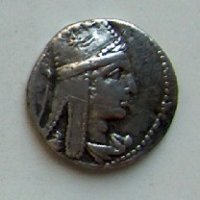
ABC News in Science
|
|
The coin features the head of the Armenian king Tigranes II the Great, who reigned from 95 to 55 BC. A symbol on his crown that features a star with a curved tail may represent the passage of Halley’s comet in 87 BC, say the Armenian and Italian researchers.
Their research will be published in Astronomy & Geophysics, a journal of the Royal Astronomical Society.
|
Halley’s comet, which was last visible in 1986, has cropped up periodically in the Earth’s history, with regular observations in 1531, 1607 and 1682.
This led Edmond Halley to declare in 1705 that this was the same comet, with an orbit taking it past the Earth about every 76 years. He predicted successfully it would return in 1758, and the comet was named after him.
Now researchers have found further evidence that the comet was significant thousands of years before Halley was born.
Tigranes could have seen Halley’s comet when it passed closest to the Sun on 6 August in 87 BC, according to the researchers, who said the comet would have been a ‘most recordable event’.
The appearance of the comet in Armenia, which borders Turkey and Iran, could be useful to date the coin accurately. While the coin dates back to before 83 BC, when Tigranes conquered the ancient city of Antioch, the capital city of Syria at the time, researchers do not know its precise date.”
[Full Story]
“Lesson 1: History, Ancient Astronomers to The Renaissance”
May 10, 2004, About.com, USA: “The study of our Universe is not new, the history of astronomy shows it to be the oldest science. People have been looking up, trying to explain the universe for as long as there have been people.
The earliest Astronomers were priests and holy men, studying the movement of celestial bodies to determine celebrations and planting cycles.
Looking back in history, the ancient Greeks were the first to start developing theories about the design of the Universe.
Previous observations of the moon had already led to the knowledge that the Earth was round. When coupled with Plato’s assertion that the sphere was the perfect geometrical shape, the original Geocentric, or Earth-Centered view of the Universe was formed.
While many earlier observers in history believed the heavens were a giant bowl covering the Earth, this new philosophy, expounded by Astronomer Eudoxus and Philosopher Aristotle in the 4th century BC, said the sun, moon, and planets hung on concentric spheres, all surrounding the Earth.”
[Full Story]
“The sky at night … as seen by the Chinese 1,300 years ago”
May 03, 2004, The Independent, UK: “The oldest known map of the stars will go on display in Britain this week in an exhibition that will demonstrate the supremacy of early Chinese astronomy.”
[Full Story]
“Astronomy study reveals ancient places of healing”
April 05, 2004, New Scientist, UK: “Mysterious T-shaped monuments scattered around the Mediterranean island of Menorca were most probably places of healing, says an archaeoastronomer who has studied the orientation of the Bronze Age monuments.
|
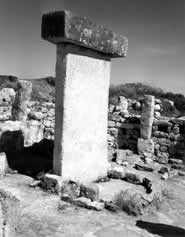
New Scientist, UK
|
|
Each ‘taula’ – named after the Catalan word for table – is formed by two massive stone blocks arranged in the shape of an upright ‘T’. The taulas face an opening in a surrounding ring of stones, and all but one of the 30 structures on Menorca face roughly south.
‘It has long been known that these taulas were sanctuaries,’ says University of Cambridge archaeoastronomer Michael Hoskin, citing the large number of bones from sacrificial animals that litter the sites.
|
But the sites were also home to a few intriguing bronze statues, including a bull, an Egyptian figurine with an inscription in hieroglyphics reading, ‘I am Imhotep the god of medicine’ and horse hooves.
The latter is particularly curious as there is no known horse god in ancient Mediterranean cultures.”
[Full Story]
“China’s oldest star observatory applies for
World Cultural Heritage listing”
April 04, 2004, XinhuaNet, China: “Dengfeng Star Observatory Platform in central China’s Henan Province, the oldest of its kindin the country, is applying to be listed as a World Cultural Heritage, said an official with the Henan provincial cultural relics administration.
The platform, built in 1276 in the early Yuan Dynasty (1271-1368), was located in a temple courtyard in Gaocheng 12 kilometers to the southeast of Dengfeng City. Built with bricks and stone, the building has two parts, the platform and the stone Chinese sundial.
On the 9.46-meter-high platform, there are two small cottages on each side. To the north of the platform is an entry and exit which are symmetrically arranged. Linking the entry and exit to the platform are stairs and pathways. Between the two pathways is the 31.19 meter-long stone Chinese sundial, which was paved by 36 slates.”
[Full Story]
“Ancient builders followed stars”
April 02, 2004, BBC Science News, UK: “Many Bronze Age monuments in Europe and Africa were erected with the Sun and other stars in mind, says Dr Michael Hoskin, a UK historian of astronomy.
|
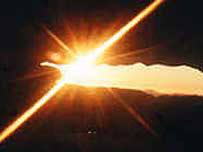
BBC Science News, UK
|
|
In one survey of 2,000 tombs he has shown how many were built to face the rising Sun – a symbol of the afterlife.
A second study of stone structures in Menorca reveals they were set up to view the constellation of Centaurus.
|
The Menorcan study centres on ‘taulas’ – from the Catalan word for table – which are rectangular stones set in bedrock with a horizontal slab placed across the top of them – to form what looks like a capital “T”.
Today, there is nothing in the sky, low to the south, which is of particular interest. But in 1,000 BC when the taulas were built, the Menorcans could have seen the constellation of the Southern Cross and the bright stars of Centaurus rising and setting in that direction.”
[Full Story]
“Builders of ancient tombs, temples followed the stars”
April 02, 2004, SpaceFlight Now, USA: “Two studies of ancient monuments in southwest Europe reveal the influence the Sun and stars had on their builders according to Dr Michael Hoskin, a historian of astronomy at Cambridge University.
In the Archeoastronomy session of the RAS National Astronomy Meeting at the Open University, he will argue that the orientation of about 30 Bronze Age sanctuaries on the island of Menorca with a clear view towards the southern constellation Centaurus, favours his interpretation of them as places of healing, such as Lourdes in France is today.
He will also tell the meeting how his own measurements of the orientation of around 2000 Neolithic tombs in western Europe and North Africa reveal that the overwhelming majority were built to face the rising Sun.”
[Full Story]
“Mystery of sacred site shaped by stars”
March 08, 2004, Yorkshire Post, England: “Thornborough is the only triple henge complex in the world and the only one to share the same astronomical alignment as the pyramids at Giza in Egypt. A recent theory is that the henges’ alignment may follow that of Orion’s Belt in the constellation of Orion.
The site, which may have been chosen because of its proximity to the River Ure, was first used about 3500BC and it continued to be a centre for religious ritual worship, drawing pilgrims from across the North, at least until 2500BC.
The henges are one of the largest earthmoving projects undertaken by Neolithic man. Together with other henges at Nunwick, Hutton Moor and Cana Barn, near Ripon, plus the Devil’s Arrows at Roecliffe, near Boroughbridge, they form one of Britain’s premier sacred sites.”
[Full Story]
“Mysterious places: The Nasca Lines
Ancient marks in Peruvian desert remain a secret”
February 25, 2004, The Epoch Times, USA: “On a lonely stretch of the Pan-American Highway, 275 miles south of Lima, Peru, lies a town called Nasca. The town sits in the Pampa region, a desolate plain on the northern tip of the Atacama Desert. What makes this area unique is the Nasca Lines – a spider’s-web of lines and shapes crisscrossing 250 sq. miles of bone-dry desert.
|
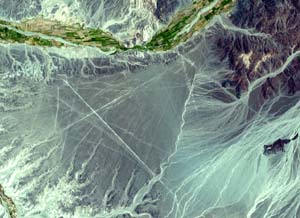
The Epoch Times, USA
|
|
Their origin and purpose has baffled scientists and laymen alike since their “discovery” in the 1920s.
The Nasca Lines consist of trapezoids and spirals, giant animal and humanoid figures, and ruler-straight lines that stretch for miles. These lines and ground drawings, called “geoglyphs,” are attributed to the Nasca race that populated this land between 200 B.C. and 600 A.D.
|
They were created by removing the top layer of dark rock from the desert floor, revealing contrasting white-yellow sand. Interestingly, the drawings are best viewed and appreciated from the air.
Dr. Paul Kosok came to the Nasca desert in the 1930s to study ancient irrigation channels. Initially, the Nasca Lines were thought to be remnants of these channels. Often travelling by foot, Dr. Kosok soon discovered large-scale drawings of animals and other objects. Over time, he theorised that the drawings represented a large astronomical chart.”
[Full Story]
“Ancient Desert Markings Imaged From Orbit”
February 20, 2004, Innovations-Report, Germany: “Visible from ESA’s Proba spacecraft 600 kilometres away in space are the largest of the many Nasca Lines; ancient desert markings now at risk from human encroachment as well as flood events feared to be increasing in frequency.
|
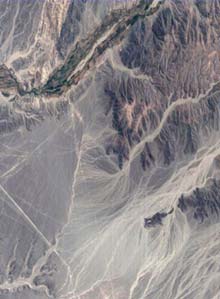
Innovations-Report, Germany
|
|
Designated a World Heritage Site in 1994, the Lines are a mixture of animal figures and long straight lines etched across an area of about 70 km by 30 km on the Nasca plain, between the Andes and Pacific Coast at the southern end of Peru.
The oldest lines date from around 400 BC and went on being created for perhaps a thousand years.
They were made simply enough, by moving dark surface stones to expose pale sand beneath. However their intended purpose remains a mystery.
|
It has variously been proposed they were created as pathways for religious processions and ceremonies, an astronomical observatory or a guide to underground water resources.
The Nasca Lines have been preserved down the centuries by extreme local dryness and a lack of erosion mechanisms, but are now coming increasingly under threat: it is estimated the last 30 years saw greater erosion and degradation of the site than the previous thousand years before them.”
[Full Story]
“Archaeologists discovered ancient city of Aztecs”
February 02, 2004, Pravda, Russia: “Archaeologists unearthed remains of Aztec’s ancient capital in Mexican suburbs. Scientists claim that the find will shed the light onto the history of mysterious civilization of the pre-Columbian America.
Chapultepec castle constructed in XVIII century as a residence of viceroys of New Spain, represents a kind of a tomb stone of the Aztec’s civilization. Stone basements of the fort hide ruins of the ancient Teotihuacan. This has been concluded by a team of Mexican archaeologists who had been excavating the massive city for the past six years.
Teotihuacan, which literally means ‘a place where Gods are born,’ still conceals many mysteries. Neither the exact date of the construction, nor the reasons for the city’s abandonment are known. The settlement has been divided into several sectors. The Avenue of the Dead, the main street of Teotihuacan divides the city into two sections. The Sun Pyramid as well as The Moon Pyramid remains well-preserved.”
[Full Story]
“Campaign to save the Nasca lines”
February 01, 2004, Graham Hancock Forum, UK: “Many of you will know of, and feel anger at, the reported damage being done to the Nasca lines as detailed in the recent news article Ancient Nazca Lines in peril – Trash, trucks, tourists threaten Peruvian archaeological site.
We at www.grahamhancock.com feel that we can’t idly sit by and watch such destruction take place. We therefore ask that if you want to do something to help that (as a preliminary measure) you email the following text (or something similar) to both UNESCO and ICOMOS who deal with the assessing and commissioning of World Heritage sites, of which Nasca is one.
UNESCO: [email protected]
ICOMOS: [email protected]
Together we might make a difference.
John Grigsby (Graham’s web-editor)“
[Graham Hancock’s Forum]
|
|
useful books from our
Astro-Archaeology
Bookshoppe
“A Little History of
Astro-Archaeology”
John F. Michell

EU English Edition
“Stonehenge today is a battlefield, not only for police and festivalgoers at midsummer but also for rival camps of archaeologists, astronomers, and other researchers into the mysteries of prehistoric religion and science. Controversy flared up in 1963, when Gerald Hawkins made early use of the computer to identify Stonehenge as an observatory for the sun and moon and an instrument for predicting eclipses. Further studies of megalithic sites by Alexander Thom proved that many of them were also related to the seasonal positions of the heavenly bodies.
The study of astro-archaeology has now expanded worldwide, bringing new revelations about the mystical sciences of antiquity. This “little history” summarizes the issues involved in astro-archaeology, and illustrates its principal sites and personalities. Included are recent findings of British scientists, whose records of anomalous levels of natural energies at stone circles are in accordance with the magical reputations of such places in local folklore.”
“Megaliths, Myths and Men:
An Introduction to
Astro-Archaeology”
Peter Lancaster Brown

EU English Edition
“Noted British astronomer’s fascinating study of early astronomical knowledge through the interpretation of Stonehenge, Carnac, other megalithic sites. Stone Age sculpture, astronomical computations, radiocarbon dating, many other topics. Over 140 maps, photos, illustrations. The author has very comprehensively analysed several sites and shown how they can be used as astronomical machines.
He discusses the different interpretations of the sites and includes many diagrams of sites including the important astronomical alignments. Very enjoyable overview of archaeo-astronomy. Brown neatly debunks the lunatic fringe, reveals some of the unsung heroes of the field, and provides a clear summary of current ideas for the lay person.”
“Stonehenge: A New Interpretation of Prehistoric Man and the Cosmos”
John David North

EU English Edition
“Argues that Stonehenge’s scientific purpose was to observe the setting midwinter sun, and that astronomical observations made by the ancient Britons were as rational and methodical as they are today. North brings his distinguished background in astronomy to this study of Neolithic monuments. His aim is ‘to discover certain patterns of intellectual and religious behavior through a study of archaeological remains that seem to have been deliberately directed in some way towards phenomena in the heavens.’
Most of this book is a painstakingly detailed on-site investigation. Judging from the scale of Stonehenge and other monuments that incorporated astronomical alignments, North argues that the heavens played a central place in Neolithic and Bronze Age religion.”
“Astronomy in Prehistoric
Britain and Ireland”
Clive Ruggles
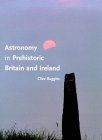
EU English Edition
“Do prehistoric stone monuments in Britain and Ireland incorporate deliberate astronomical alignments, and if so, what is their purpose and meaning? This work provides an account of megalithic astronomy debates and examines prehistoric man’s concern with celestial bodies and events. For decades debates have boiled among archaeologists and astronomers over the idea that prehistoric stone monuments in Britain deliberately incorporate astronomical alignments.
In this book Clive Ruggles is the first to approach the subject from the perspectives of both disciplines. He analyzes the history and lessons of previous debates, the most current research, and new agendas for future research.”
“Ancient Astronomers
(Exploring the Ancient World)”
Anthony F. Aveni
&
Jeremy A. Sabloff
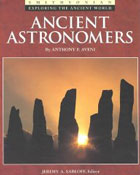
EU English Edition
“Anthony Aveni is well known in scholastic circles for his many excellent and ground-breaking publications in the field of archaeoastronomy. This particular volume is geared toward interested laymen and uninitiated scholars who are not yet well grounded in the history of astronomy or ideas of cosmology from an anthropological perspective. The book is graced with numerous and apt illustrations, while the text reads easily with Aveni’s smooth and informative style.
Chapters were clearly organized thoughtfully, as information builds upon previous explanations and new concepts or ideas are charted out for the neophytes as needed. “Ancient Astronomy” provides an ideal introduction to archaeoastronomy, ethnoastronomy, and cosmology for students in anthropology and the history of astronomy.”
“Prehistoric Astronomy
in the Southwest”
J. McKim Malville
&
Claudia Putnam
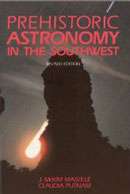
EU English Edition
“Archaeoastronomy is a discipline pioneered at Stonehenge and other megalithic sites in Britain and France. Many sites in the southwestern United States have yielded evidence of the prehistoric Anasazi’s intense interest in astronomy, similar to that of the megalithic cultures of Europe. The authors describe the astronomical alignments at the well-known sites of Chaco Canyon and Hovenweep and present new evidence, based on recent field work of alignments at Yellow Jacket, Chimney Rock, and Mesa Verde.
Drawing on the archaeological evidence, ethnographical parallels with historic pueblo peoples, and mythology from other cultures around the world, the authors present theories about the meaning and function of the mysterious stone alignments and architectural orientations of the prehistoric Southwest.”
“Stairways to the Stars: Skywatching in Three Great Ancient Cultures”
Anthony F. Aveni
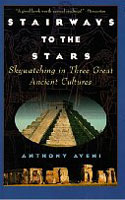
EU English Edition
“What is the meaning of Stonehenge? Why was the elaborate Incan city of Cuzco built? What is the significance of the Great Pyramid at the ancient Mayan city of Chichén Itz´? These ancient structures have spellbound natives and tourists alike. This mysterious architecture points to a centuries-old search for celestial order. Anthony Aveni, a professor of astronomy and anthropology, takes us on a stimulating virtual tour of these legendary constructions.
He describes how they were built and straightforwardly and often humorously critiques diverse theories attempting to explain their origin and function. For example, Aveni breathes life into the mysteries of the Great Pyramid and its use as a sacred temple, sacrificial altar, and celestial calendar.”
“Songs from the Sky: Indigenous Astronomical and Cosmological Traditions of the World”
V.D. Chamberlain (Editor)
J.B. Carlson (Editor)
M.J. Young (Editor)
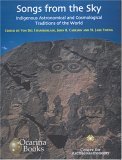
EU English Edition
“This substantial collection of papers on indigenous astronomical knowledge is quite unequalled in its scope and extent. The authors are drawn from a variety of academic disciplines, including anthropology, archaeology, astronomy, engineering, art history, history of science, history of religion, folklore, and mythology, and bring a variety of academic perspectives to bear upon aspects of celestial knowledge and perception in diverse social contexts from many different parts of the globe.
The Americas provide the main geographical focus, with twenty of the 32 papers concerning indigenous north American groups such as the Navajo, Lakota, Zuni and Blackfoot, the Mixe and Tzotzil Maya of southern Mexico, the Andean highlands and the Amazonian region of Peru, and southern coastal Brazil. The remaining twelve articles extend to the Arab world, sub-Saharan Africa, southern India, Java, Melanesia, Australia and Polynesia, with a few addressing broader synthetic themes. For a number of the culture areas dealt with in some detail here, other published information about sky knowledge is extremely scant.”
“East Asian Archaeoastronomy: Astronomical Observations of China, Japan and Korea”
Xu Zhentao, Jiang Yaotiao,
David W. Pankenier

EU English Edition
“Historical astronomical records can play an important role in modern research, especially in the case of ancient Chinese observational data: sunspot and aurora records are important for the study of solar variability; solar and lunar eclipse records for the study of the Earth’s rotation; records of Comet Hally for the study of orbital evolution; “guest star” records for the study of supernova remnants; planetary conjunction records for research in astronomical chronology.
In the past, Western scientists have not been able to exploit these valuable data fully because the original records were difficult to gather and interpret, and complete English translations have not been available. East-Asian Archaeoastronomy is the first comprehensive translation into English of such historical records for modern research.
The book also features an introduction to East Asian astronomy and offers guidance on how to use the records effectively. It will not only be a valuable research tool for astronomers but should also be of great interest to historians of China and Chinese science. Xu; Zhenoao Purple Mountin Observatory,Pankenier; W Department of Modern Foreign Language and Literatur,Yaotiao; Jiang Nanjing University , China.”
“Exploring Ancient Skies: An Encyclopedic Survey of Archaeoastronomy”
David Humiston Kelley
&
Eugene F. Milone
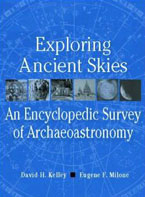
EU English Edition
“Exploring Ancient Skies brings together the methods of archaeology and the insights of modern astronomy to explore the science of astronomy as it was practiced in various cultures prior to the invention of the telescope. The book reviews an enormous and growing body of literature on the cultures of the ancient Mediterranean, the Far East, and the New World (particularly Mesoamerica), putting the ancient astronomical materials into their archaeological and cultural contexts.
The authors begin with an overview of the field and proceed to essential aspects of naked-eye astronomy, followed by an examination of specific cultures. The book concludes by taking into account the purposes of ancient astronomy: astrology, navigation, calendar regulation, and (not least) the understanding of our place and role in the universe.
Skies are recreated to display critical events as they would have appeared to ancient observers – events such as the supernova of 1054, the ‘lion horoscope’ or the ‘Star of Bethlehem.’Exploring Ancient Skies provides a comprehensive overview of the relationships between astronomy and other areas of human investigation. It will be useful as a reference for scholars and students in both astronomy and archaeology, and will be of compelling interest to readers who seek a broad understanding of our collective intellectual history.”
“Echoes of the Ancient Skies: The Astronomy of Lost Civilizations”
E.C. Krupp
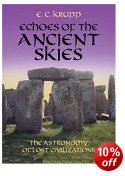
EU English Edition
“All over the world, through countless centuries, people have looked skyward for inspiration and guidance in their lives and activities. For most of the history of humankind, going back to the Stone Age, the sky has served as a tool. The regularity of the motions of celestial objects enabled our ancestors to orient themselves in time and space, satisfying their need for human order. How vast this heavenly influence was, and how awesome the human achievements it engendered were, are illuminated in this extraordinary work of investigation and discovery.
With hundreds of illustrations and photographs, Echoes of the Ancient Skies is a sweeping look at the world of archaeoastronomy from the prehistoric megaliths of Stonehenge, to the medicine wheels of North America, to the Aztec “Calendar Stone.”
The intriguing field of archaeoastronomy–the study of ancient peoples’ observation of the skies and its role in their cultural evolution–seeks to explore the “universal evidence that people have used astronomy as the model for injecting order and predictability on their behavior and on life.” Examining this universal behavior, Dr. E.C. Krupp takes the reader to sites throughout the world (most of which he has personally visited)–from Egypt, China, Babylonia, and Greece, to Turkey, Scotland, Wyoming, and Mexico. He interprets the significance of celestial observation and its relation to the earthly experiences of our ancestors, from practical applications of farming and the measurement of time to philosophical queries into our particular place within the universe.”
“The Stones of Time : Calendars, Sundials, and Stone Chambers
of Ancient Ireland”
Martin Brennan
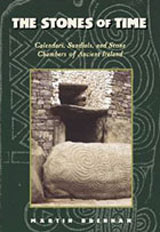
EU English Edition
“The Stones of Time presents one of the most dramatic archaeological detective stories of our time. Predating Stonehenge by at least a thousand years, the stone complexes of ancient Ireland have been extensively studied, yet have refused to give up their mystery. The most complete record of Irish megalithic art ever published.
Martin Brennan is a New York artist who spent three years of study on prehistoric art in Mexico and a similar period in Japan. Of Irish parentage, he was drawn to Ireland and the Boyne Valley, where he spent six years studying the neolithic stone chambers and their symbolic art before formulating the groundbreaking theories set forth in this book.”
“America’s Stonehenge:
The Mystery Hill Story”
David Goudsward
&
Robert E. Stone
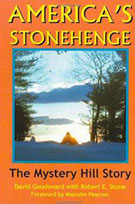
EU English Edition
“America’s Stonehenge sits atop Mystery Hill in North Salem, New Hampshire. It is an acre of stone structures surrounded by a 12-acre calendar. Alignments and carbon dating indicate the site was built 4000 years ago. In this book the authors explore the historical and prehistoric clues left behind at the archaeology site once described as a ‘mystery wrapped in an enigma’.
The history of the site is examined and traced from the clues left behind from visitors, residents and researchers, and how that has led to today’s research and the current interpretation of the evidence.”
“Skywatchers, Shamans and Kings: Astronomy and the
Archaeology of Power”
E.C. Krupp
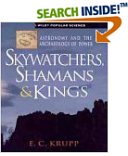
EU English Edition
“Discover the celestial myths and cosmic rituals of ancient priests and kings … Drawing on intimate knowledge of the more than 1,300 ancient sites he has visited, E. C. Krupp, acclaimed writer and preeminent researcher, takes you to the world’s essential sacred places and celestial shrines. Join him on a rich narrative journey to see where the rulers of old communed with the gods of the sky.
They ruled kingdoms and empires for thousands of years, tracing their lineages to gods in the sky and mastering the forces they believed moved the sun and moon, planets and stars. In an evocative, illustration-rich journey through lost civilizations, E. C. Krupp describes the workings of sky worship practiced by the pharaohs, emperors, lamas, and shamans of old.”
“In Search of Chaco:
New Approaches to an
Archaeological Enigma”
David Grant Noble
(Editor)
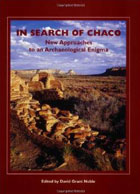
EU English Edition
“Startling discoveries and impassioned debates have emerged from the “Chaco Phenomenon” since the publication of New Light on Chaco Canyon twenty years ago. This completely updated edition features seventeen original essays, scores of photographs, maps, and site plans, and the perspectives of archaeologists, historians, and Native American thinkers.
Key topics include the rise of early greathouses; the structure of agricultural life among the people of Chaco Canyon; their use of sacred geography and astronomy in organizing their spiritual cosmology; indigenous knowledge about Chaco from the perspective of Hopi, Tewa, and Navajo peoples; and the place of Chaco in the wider world of archaeology.”
“Mysterious Britain”

VHS NTSC version
(USA and Canada)
VHS UK PAL version
(UK and Europe)
|